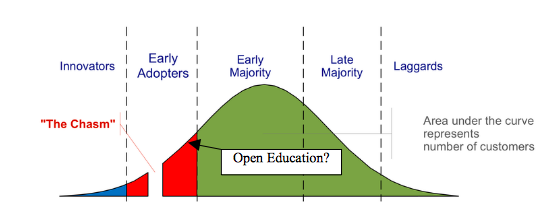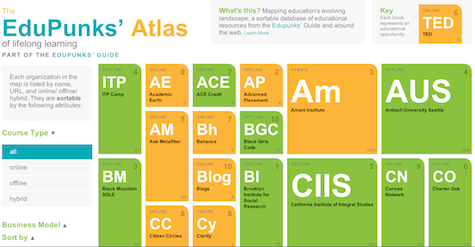Mashable wrote about open education recently. This month’s Fast Company (not-quite-so-fast web edition not yet available as of this post) features an article on it. The venture capitalists have been circling for a while. Since it started opening major parts of its curriculum to open access via the Web in 2001, MIT OpenCourseWare has been joined by more than 200 other institutions with similar projects.
Is open education starting to enter the mainstream?

Based purely on user numbers, you might argue that it entered the mainstream some time ago: more than 56 million users have accessed MIT’s open courseware initiative alone. No doubt many multiples of that number have accessed the wide range of open educational resources now available across the Web.
But any dotcom entrepreneur can tell you that user numbers do not necessarily equate to sustainability – a quality that tends to be favored in the mainstream. As Geoffrey Moore argued nearly two decades ago in Crossing the Chasm, there is generally a significant gap – a chasm – between the early visionaries for an innovation and the pragmatists who take it into the mainstream. The latter most definitely seek sustainability – and more often than not, a measurable return on their investment.
Why does all of this matter from the standpoint of the lifelong learner? There are positives and negatives.
One huge positive is clear: the open education movement as a whole has been a significant force in introducing free educational content onto the Web, and arguably, helping to keep quality levels higher than might have otherwise been the case. Having institutions like MIT, Yale, and Berkeley in the game certainly raises the stakes some. More visibility for open education and its potential role in bringing down the costs of formal education could lead to more, and more strategic, investment in open educational resources that may benefit lifelong learners.
On the other hand, money always has a tendency to muddy the waters. The Fast Company article, for instance, seems to lump together such diverse efforts as the open courseware consortium (which offers conent completely free for learners), University of the People (which charges fees, albeit very reasonable ones, for participation), and Knewton (a venture-funded start-up that charges $890 for test prep courses). Each of these initiatives signals a seismic shift in the world of education, but the degree of true “openess” varies dramatically across them.
How sustainable structures are built for carrying open education forward – and whether these structures represent foundations or simply new and different walls – seems now to be the core issue. That the movement has evolved to this level – and that an array of new hands are contributing to the work – strikes me as the clearest sign that open education has crossed the chasm and is poised to become part of the mainstream educational landscape.
Wherever it all ends up, the open education movement has helped spark a broad debate about the cost of education, the value of our traditional approaches to validating and accrediting education, and the role of traditional institutions like the university (which open education leader David Wiley, quoted and pictured in the Fast Company article, has said could be “irrelevant by 2020.”) As this debate continues to gain ground, so too will open education.
What do you think – have we crossed the chasm? Is open education entering the mainstream?
Jeff Cobb
Mission to Learn
P.S. 11-Aug- 09 – I did not notice until this morning (via Downes) that the Open Education Conference is using “Crossing the Chasm” as its tag line this year. A coincidence, but a serendipitous one in signaling that some of the people closest to the movement sense that a major shift is occurring. See also the Chronicle article on Obama’s Great Course Giveaway referenced by Downes.
P.S.S. – If you enjoy what you read here on Mission to Learn, subscribe to the RSS feed or use the e-mail subscription form at the top right side of this page.





Miguel – I share the sentiment. Wealthier countries with established educational systems seem relatively open to producing open educational content, but to actually validate it as a form of education that “counts” is another matter. RE: “How many people on OC are from these countries? Is there any study on that?” – I suspect there is, though I don’t know of it off the top of my head. I’ll do some searching, but if anyone else reading knows of something, please comment. – Jeff
My feeling is that countries with established educational systems may face more resistence to accept Open Courses – there are too many “stakeholders” involved and the main question still is “Where will money come from?”. Otherwise, countries as China, India and Brazil – where public education is poor and people are seeking opportunities to grow – Open Courses will be seen as a chance for personal and professional improvement and will overtake the Chasm sooner.
How many people on OC are from these countries? Is there any study on that?
Pingback: Open social Learning, educación abierta, ¿camino de ser mayoritaria? » El caparazon
Joseph – Thanks for the comment and for being a long time reader. Both are appreciated! And thanks for mentioning CCLearn – I should have figured out some way to work it into the post. RE: Knewton – that’s Fast Company’s example, not mine – just to be clear. I agree that Knewton is “not-so-much” as far as openess go. I think the Fast Company mixes apples and oranges to a large extent. – Jeff
I think that OER is getting closer to the mainstream. Just look at the major initiatives by CClearn recently. At least CC is giving it major attention. The problem I think, which you touched on, is that no one really knows what this looks like. To date the best “resources” of OER are search engines. Which is great, but not so well organized if you look even at Wikipedia as a OER sample (imagine if the same organization principles could be applied to ALL OER content available on the web?).
Part of the problem is that no 1 entity has come forward with enough clout, support, funding to propose such a desitination for OER (a global repository of OER where anyone can post and remixing, reusing and submitting is simple, easy and free). At some point someone–maybe a consortium of governments or colleges–might do it (but I do not know if there ever would be $ in it…it’s quite possible that a global OER repository, while invaluable to the entire internet using population, would be a tremendous drain of resources). After all they did the same with the world seed bank.
Also, to comment on your examples of major initiatives, I think UofPeople and the OCWC are great, but Knewton doesn’t exactly contribute to the world of OER. Educational innovation yes, openness not-so-much.
That being said, wonderful post. I’m a long time subscriber so keep it up!
Neil – Thanks for taking the time to comment. I can’t say I feel rock solid in asserting that open ed has crossed the chasm – and I would definitely not place it in the early majority phase at this point – but it does seem like a fundamental shift has occurred during the course of the past year or so, one that is different from the move from innovators into early adopters. I’d agree that there probably is not a broad perception of open education as an “established social fact,” but on the other hand, it seems clearer and clearer that it is a phenomenon that is not going away. And I’m not sure the question of vision and integration can really be separated – the visionaries may continue debating the vision, as have Web 2.0 and social media visionaries – but meanwhile the work of integration starts to take on a life of its own. Perhaps a matter of perception – or angels on a pinhead – but a “For Dummies…” book in my mind would be a bellwether of the early majority phase peaking and descending into late majority. I look forward (I think!) to seeing that book published. – Jeff
I’m not so sure that I’d say it has crossed the chasm yet. I say this because the idea still seems to be being primarily carried and promoted by its prophets and evangelists ( Moore’s enthusiasts and visionaries) – be they individuals or institutions. The very fact that the conference tag line is “Crossing the Chasm” suggests that enthusiasts see this as their next challenge, I think.
The early majority are pragmatists – they are less interested in the vision and more interested in simply integrating the new ideas/tools in their workflow. “Social media” or “Web 2.0” technologies have crossed the chasm, without yet fully leaving the early adopter space, I’d suggest. The discourse around those tools/ideas are more like – “What can Twitter do for my business?”, “What social media policies should my organization enact?”, “Should my company have a Facebook profile?”… etc. That is post-chasm early-adopter-speak, in my estimation. The new idea is treated as an established social fact, but people are still trying to figure out the strategies for integrating it (or the early innovators have figured a lot of them out, and are now helping their first few cohorts of clients).
For OER, I think the battle is still over what the vision looks like, which is part of a deeper battle over what the role of education in society is, and what kind of economic models will support these competing visions. We’re still envisioning (and running pilot projects), and still evangelizing against competing visions. I don’t think there is a “Using OER and Learning Assessment Services to get your degree by accredited-portfolio – For Dummies” book out yet (an early-majority indicator?). There have been “For Dummies” books out on how to use Web 2.0 tools for some time. But that kind of an OER book would be an example of OER being taken as an established social fact, with the concern shifting from developing and articulating the vision of OER to more pragmatic concerns about using them.